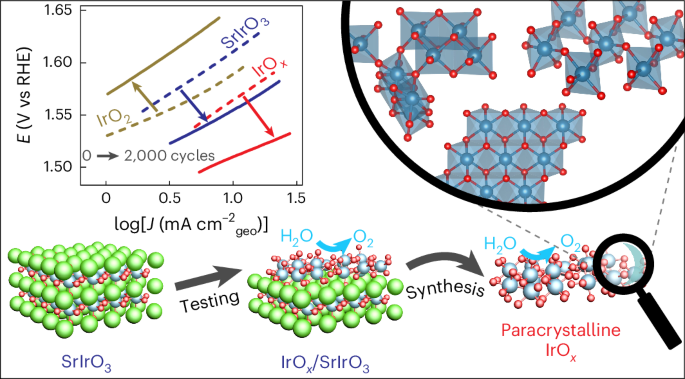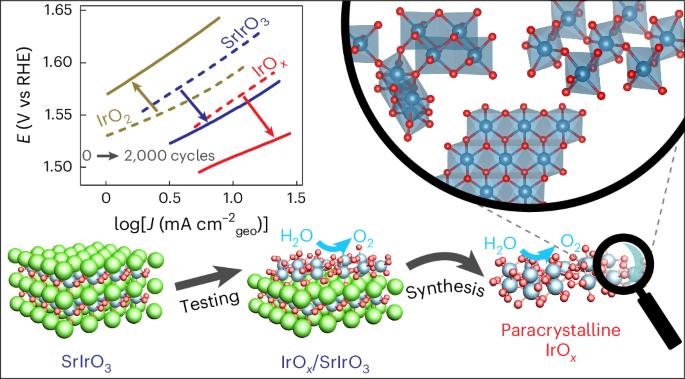Key role of paracrystalline motifs on iridium oxide surfaces for acidic water oxidation
IF 44.6
1区 化学
Q1 CHEMISTRY, PHYSICAL
引用次数: 0
Abstract
Water electrolysis using proton exchange membrane technology offers an ideal process for green hydrogen production, but widespread deployment is inhibited by insufficient catalyst activity, stability and affordability. Iridium-based oxides provide the best overall performance for acidic water oxidation, the limiting reaction for this process, but further improvements are impeded by poor understanding of the restructured active catalyst surface that forms under reaction conditions. Here we present a combination of X-ray and electron scattering data that reveals direct evidence for three paracrystalline structural motifs at the restructured surfaces of highly active catalysts (including rutile IrO2 and perovskite SrIrO3) that have previously been described as amorphous. These insights enable the design of a paracrystalline IrOx catalyst that is independent of the bulk crystalline support and maintains higher activity, longer stability and more effective use of iridium to promote the production of green hydrogen. Iridium-based oxides are the most active catalysts for acidic water oxidation, but a complete understanding of their surface reconstruction under operation remains elusive. Now three key paracrystalline structural motifs are identified on the seemingly amorphous reconstructed IrOx surface.


氧化铱表面副晶图案在酸性水氧化中的关键作用
利用质子交换膜技术进行水电解是一种理想的绿色制氢工艺,但催化剂活性、稳定性和经济性不足阻碍了该工艺的广泛应用。铱基氧化物在酸性水氧化(该工艺的限制反应)方面具有最佳的整体性能,但由于对反应条件下形成的重组活性催化剂表面了解甚少,阻碍了进一步的改进。在此,我们结合 X 射线和电子散射数据,揭示了在高活性催化剂(包括金红石型 IrO2 和过氧化物型 SrIrO3)的重组表面上存在三种准晶体结构图案的直接证据,而这些图案之前被描述为非晶体。有了这些见解,就能设计出一种独立于块状晶体支撑物的准晶体 IrOx 催化剂,这种催化剂能保持更高的活性、更长的稳定性和更有效的铱利用率,从而促进绿色氢气的生产。
本文章由计算机程序翻译,如有差异,请以英文原文为准。
求助全文
约1分钟内获得全文
求助全文
来源期刊

Nature Catalysis
Chemical Engineering-Bioengineering
CiteScore
52.10
自引率
1.10%
发文量
140
期刊介绍:
Nature Catalysis serves as a platform for researchers across chemistry and related fields, focusing on homogeneous catalysis, heterogeneous catalysis, and biocatalysts, encompassing both fundamental and applied studies. With a particular emphasis on advancing sustainable industries and processes, the journal provides comprehensive coverage of catalysis research, appealing to scientists, engineers, and researchers in academia and industry.
Maintaining the high standards of the Nature brand, Nature Catalysis boasts a dedicated team of professional editors, rigorous peer-review processes, and swift publication times, ensuring editorial independence and quality. The journal publishes work spanning heterogeneous catalysis, homogeneous catalysis, and biocatalysis, covering areas such as catalytic synthesis, mechanisms, characterization, computational studies, nanoparticle catalysis, electrocatalysis, photocatalysis, environmental catalysis, asymmetric catalysis, and various forms of organocatalysis.
 求助内容:
求助内容: 应助结果提醒方式:
应助结果提醒方式:


